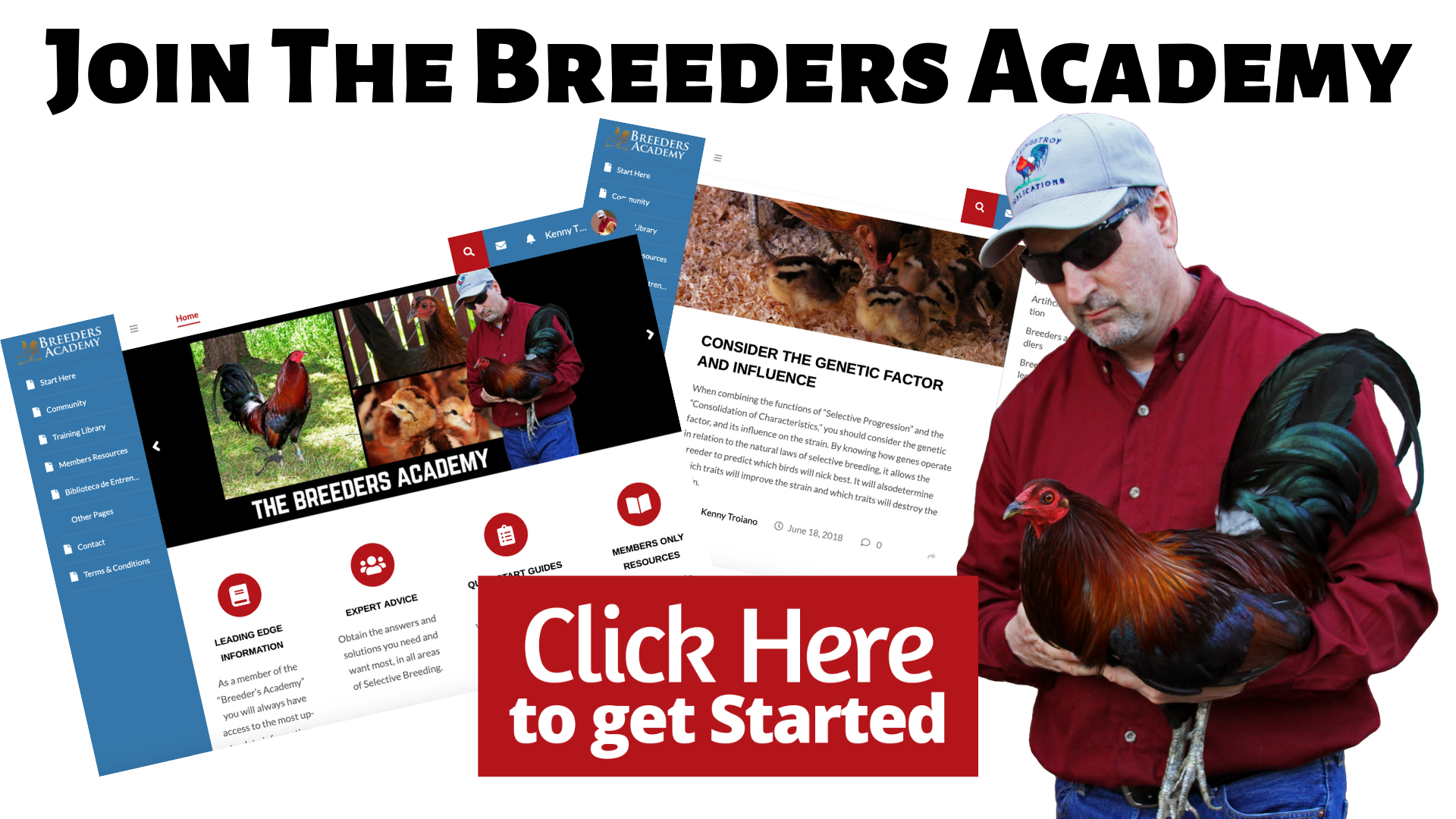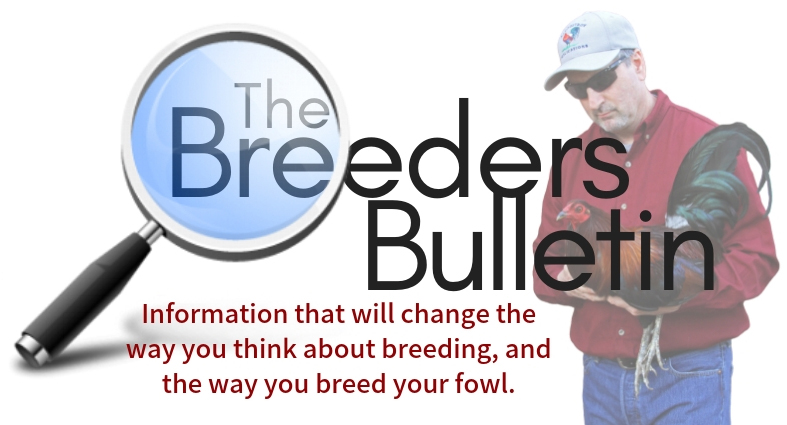These are the most common ways, but they can be very risky
By Kenny Troiano
Copyright © 2019 by Kenny Troiano/Maximus Troy Publications
There are two ways of acquiring good foundation fowl, (1) is to create your own. The other, (2) is to purchase fowl from other breeders. Both have their fair share of benefits as well as problems.
The truth is – there are very few experienced breeders out there who are interested in breeding and perpetuating superior strain(s). Rather than creating their own, the majority of breeders find it easier to let the so-called “Big-Time Breeder” do it for them. But the results are never what they expect.
Every year they buy new fowl, and every year they are disappointed in the fowl they receive. They make their selections based on old wives tales, and superstitions. And worst of all, they search for strains with popular names, such as Hatch, Sweater, Roundhead, and Kelso, just to name a few. The problem with this method is that they are buying “Names” not high quality, superior fowl.
They read the advertisements in the magazines, without any real research of the breeders who listed them, and make their decision based on the name of the strain and the good looking picture in the ad.
When inquiring about the fowl, that they are interested in purchasing, they neglect to ask the breeder the two most important questions: “what methods of breeding does this breeder use?” and “what are the breeding tendencies of their strain(s)?” For instance, do they practice inbreeding and line-breeding, or do they practice crossbreeding. And, what are their strains most common defects? Every family expresses a defect from time to time, what are they?
After talking to the breeder for a while, they decide to order his fowl, even though they do not know the conditions for which the fowl are raised, and how well they are managed.
What happens next is very interesting?They order a trio and send their money, a lot of it too. Finally, the fowl arrive, and it’s time to open the box. They know, intuitively, that the future of “what could be” lays waiting in that box, so with anxious anticipation they begin to open the box.
Side note: It’s always a mystery to see what comes out of that box. They could be really good or really bad, you never know. But in truth, they tend to be mediocre.
As the box is opened, and the birds are pulled out, one at a time, they take some time to examine the birds. Are they good, or are the really bad? Feeling a bit uncertain, they can’t decide whether they like them or not. They want to like them, but they can’t figure out what it is that bothers them about the birds, so they talk themselves into believing that the birds are fine, and decide to breed them.
After years of trying to improve them, the fowl really never amount to anything, and remain somewhat mediocre. Giving up on the idea of keeping the family pure, they begin to cross them with other fowl. Seeing an improvement in the crosses, due to hybrid-vigor, they now believe crossbreeding is the way to go, and that there is no such thing as a pure family. They become, like so many, a perpetual cross-breeder.
It is a pattern I see often. The outcome might have been quite different if they would have started with better fowl.
Here is a list of potential risks when ordering fowl through the mail. Be ready to accept one or all of these possibilities as you open that box.
- They may be in poor physical condition
- They may lack the proper conformation of body and color of plumage
- They may even have a defect or two to boot
- They may have a bad disposition, poor performance ability, and not be game
- Or simply, they may be quite different than originally advertised
Another possible scenario: Let’s say, for arguments sake, that the fowl you received are in great shape and are healthy. They have a good conformation of body and color of plumage. They have a great temperament, good performance ability, and are game. And they are free of defects. At first glance, they seem like true representatives of the breed.
Now that you have great fowl, are your problems over? Hardly! Why? Because there are many unknowns when purchasing fowl through the mail. How the original breeder bred and maintained the bloodline is the most significant of the unknowns. The birds may look great on the surface, but after a few years of breeding, those unknowns begin to show their ugly faces.
But let’s accept, for the time being, that the fowl look great and you have no reason to doubt the breeder or his fowl. Let’s also assume that your intentions are in the right place. Your plans are to invest in this strain and properly maintain them, and with a little time, hopefully improve them as well.
As soon as they arrive, through the mail, you pull them out of the box. Wow! They look great! – You say to yourself. Excited about the future and anxious to get started, you quickly put them in the brood pen and begin to breed them. The first clutch of chicks look great, they are health and active, and they are growing and developing as expected. Every day they seem more and more promising. You even call the breeder to thank him for the great fowl.
The next year, when the offspring are fully matured, you select the best individuals for breeding, and you breed your best pullets back to the original cock, and breed the two best stags to the original hens. Expecting even better, or at least the same results as last year, the offspring seem to look and act a little different. They are healthy and active, but they have lost some of their uniformity. The more they develop and mature, the less promising they seem to be.
Due to the subtle inconsistencies between the offspring, you find that selecting the best stags and pullets is a little more difficult this time. But you do your best to select pullets and stags that can improve the strain and you move forward.
The following year, you notice that the offspring are coming all different sizes and shapes, and their conformation of body and color of plumage is neither uniform nor consistent. And the majority of the offspring are mediocre at best. There’s not very many, if any at all, what I like to call “standouts.” These are offspring that look and act far better than their sibs. Now you are concerned, and you should be.
It is usually in the third season when everything falls apart, after a considerable amount of money and time has been invested. This is when you realize that your fowl are nothing like you thought they would be, and you question their breeding and genetic quality. You then start asking everyone you meet – “What’s wrong with my fowl?” and “How do I fix them?”
You follow the advice of others and begin trying anything and everything under the sun to fix the problem, but no success. They just keep getting worst. So, you decide to call the original breeder for advice, but he’s not very helpful, and his solution to the problem is confusing and vague. As the discussion progresses, you come to the realization that the fowl you bought were not pure. They were nothing but crosses. And when you express to him that you expected a pure family, he tells you that there is no such thing as pure.
If this breeder, and I really hate calling him a breeder, truly believes that nothing is pure, then I shudder to think how messed up genetically those fowl actually may be. Since these fowl are not a true bloodline, there is nothing to maintain. The only reason they looked so good in the beginning was because they were hybrid-crosses. This is known as Heterosis, and is responsible for Hybrid-Vigor, which can make the offspring of ordinary fowl into extraordinary fowl. However, you cannot breed to hybrids. They never reproduce their kind. When you are breeding from hybrid-crosses your results will be unpredictable – in this case, “like does not beget like.”
Some will stick it out and try to improve them, but to no avail. The birds turn out to be mediocre at best. Your best option, at this point, is to abandon what you thought the fowl should be, and begin creating a new strain. However, due to the diversity of genes, they will change, and quite a bit too. The best you can do with these fowl is to continue breeding to the very best individuals, and cull the rest. Try to achieve some kind if uniformity, and in time they should improve. As mixed up genetically as they are, it will be somewhat difficult, but it can be done.
I ask you, why spend a lot of money on crosses, when they can be produced for free. It doesn’t require a genius to produce crosses. But it does require a Master Breeder to create a high quality, superior strain. When you begin with crap, you end up with crap! Breeders such as these are nothing but peddlers, and they really hinder the future of the breed. Sorry, but I don’t respect how they think or how they breed their fowl!
To acquire a good foundation, make sure to get the best fowl possible, from a reliable breeder who knows the value of “Pure” strains.


